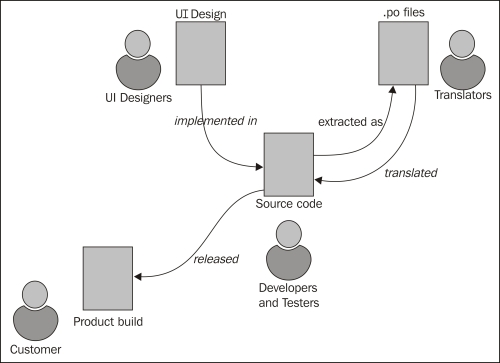From the actions we did, we know that we need a process to do the localization. Localization (often abbreviated as L10n) is a further step after internationalization. It is where the actual work specific to the target market area is done. We need this process as it involves the translators who usually can't even build the application.

The previous diagram shows a very simplified L10n process. The source code is produced by the developers according to the UI design. The design could be in formal documents or mockups. During the development, the developers add text into the source code and UI files. These texts are then extracted to .po files for each language of the target markets.
Here, the translators own the files until they are fully translated. The translated files are then handed over back to the developers. The developers and testers could make a build to test. Whenever a milestone is due, the product build is created along with the translation and delivered to the customer.
We need to set up a good infrastructure to make our life easier. The whole scenario described previously should be done in an automated way, so no delay should be produced between the steps.
In reality, before a build is delivered to the customer, a series of tests with each locale must be carried out thoroughly. Most of the time, the translators could easily get lost without a context while translating the UI text. This error can be minimized by using comments in the translation file; however, there is another issue that makes the test important. This is about how the text is displayed. There must be a check to find whether they are truncated in the translation or not. If it is, then check whether an engineering process must be carried out (for example, to resize the text size) or the translator must figure out an alternative translation. The tester should also check whether the text is rendered correctly or not. If the target market involves countries with Asian languages, or languages that are written in both the left and right direction, then the test must be carried out even more carefully.